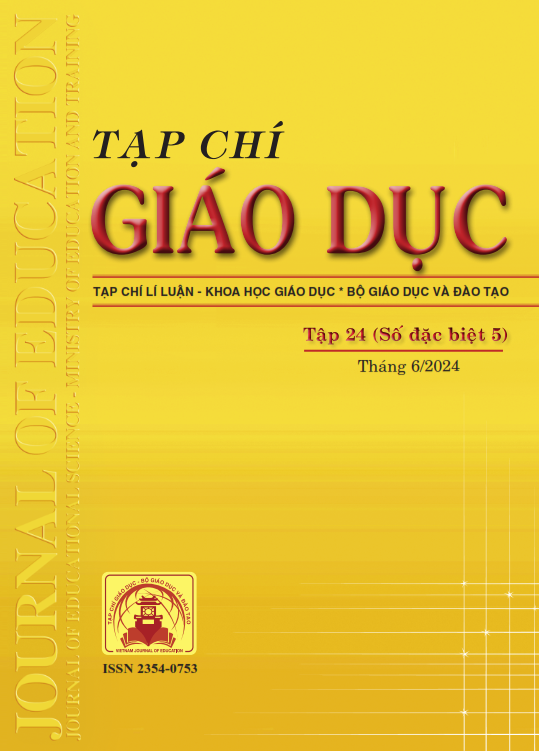Giải pháp tự học cho sinh viên sư phạm với nền tảng Internet kết nối vạn vật (Internet of Things)
Tóm tắt
Innovating teaching methods in the era of the 4.0 industrial revolution along with the outstanding development and application of information and communication technology in education and training is an urgent task. A learning ecosystem with the Internet of Things (IoT) platform has provided learners with a multi-dimensional learning environment in accessing knowledge and developing learning competence, including self-study competence. This research provides a basis for changing teaching methods and teaching self-study to students with the advancement of technology; introducing a learning ecosystem with IoT; presenting self-study in the era of the 5th level of communication and offering some solutions to improve self-study methods associated with IoT to help students equip themselves with knowledge and learning competence in teaching activities in pedagogical training universities. The results of this research aim to develop the self-study competence of pedagogical students towards innovating teaching and learning methods that are being set in universities in today's era of technology and digitalization. Students' self-study plays a very important role and is a direct factor in improving the training quality at universities. This is a task that will continue to be discussed in the future.
Tài liệu tham khảo
Ağırman, N., & Ercoşkun, M. H. (2022). History of the Flipped classroom model and uses of the Flipped classroom concept. International Journal of Curriculum and Instructional Studies, 12(1), 71-88. https://doi.org/10.31704/ ijocis.2022.004
Ban Bí thư Trung ương Đảng (2011). Hồ Chí Minh toàn tập (tập 5). NXB Chính trị Quốc gia - Sự thật.
Cohen, L., Manion, L., & Morrison, K. (2011). Research methods in education. Routledge.
Đỗ Khánh Năm (2017). Phát triển kĩ năng tự học cho sinh viên. Tạp chí Khoa học giáo dục Việt Nam, 38, 41-45.
Farhan, M., Jabbar, S., Aslam, M., Hammoudeh, M., Ahmad, M., Khalid, S., & Han, K., (2018). IoT-based students interaction framework using attention-scoring assessment in eLearning. Future Generation Computer Systems, 79, 909-919.
Hồ Ngọc Đại (1996). Tâm lí học dạy học. NXB Khoa học và Kĩ thuật.
Kiều Phương Thùy, Nguyễn Chí Trung (2021). Một số giải pháp phát triển năng lực tự học cho học sinh thông qua dạy học “chủ đề F. Giải quyết vấn đề với sự trợ giúp của máy tính” (Tin học 10). Tạp chí Giáo dục, 515, 29-34.
Madakam, S., Lake, V., Lake, V., & Lake, V. (2015). Internet of Things (IoT): A literature review. Journal of Computer and Communications, 3(05), 164-173.
Matsun, M., Hadiati, S., & Saputri, D. F. (2022). Development of IoT-Based Physics Learning Media and Its Effect on Students’ Critical Thinking Ability. Jurnal Penelitian Pendidikan IPA, 8(5), 2241-2246. https://doi.org/10.29303/jppipa.v8i5.2284
Nguyễn Cảnh Toàn (1997). Quá trình dạy - Tự học. NXB Giáo dục.
Phan Bích Ngọc (2009). Tổ chức tốt việc tự học cho sinh viên nhằm nâng cao chất lượng đào tạo của các trường đại học theo hình thức tín chỉ hiện nay. Tạp chí Khoa học, Đại học Quốc gia Hà Nội, 25(3), 160-164.
Phan Chí Thành (2018). Cách mạng công nghiệp 4.0 - Xu thế phát triển của giáo dục trực tuyến. Tạp chí Giáo dục, 421, 43-46.
Tutkyshbayeva, S., Zakirova, A. (2024). Analysing IoT Digital Education: Fostering Students’ Understanding and Digital Literacy. International Journal of Engineering Pedagogy (iJEP), 14(4), 4-23.
Van Tran, H., Thanh Le, H., Chi Phan, T., Phuoc Hoang, L., & Minh Phan, T. (2022). Flipped classroom in online teaching: a high school experience. Interactive Learning Environments, 1-17. https://doi.org/10.1080/ 10494820.2022.2120020
Xue, R., Wang, L., & Chen, J. (2011). Using the IoT to construct ubiquitous learning environment. Second International Conference on Mechanic Automation and Control Engineering, 7878-7880.
Đã Xuất bản
Cách trích dẫn
Số
Chuyên mục
Giấy phép

Tác phẩm này được cấp phép theo Ghi nhận tác giả của Creative Commons Giấy phép quốc tế 4.0 .












